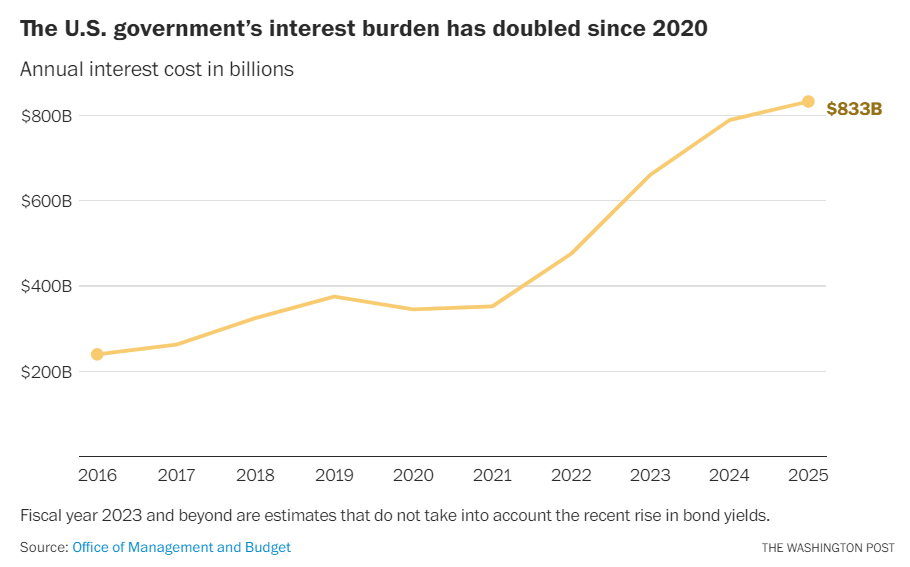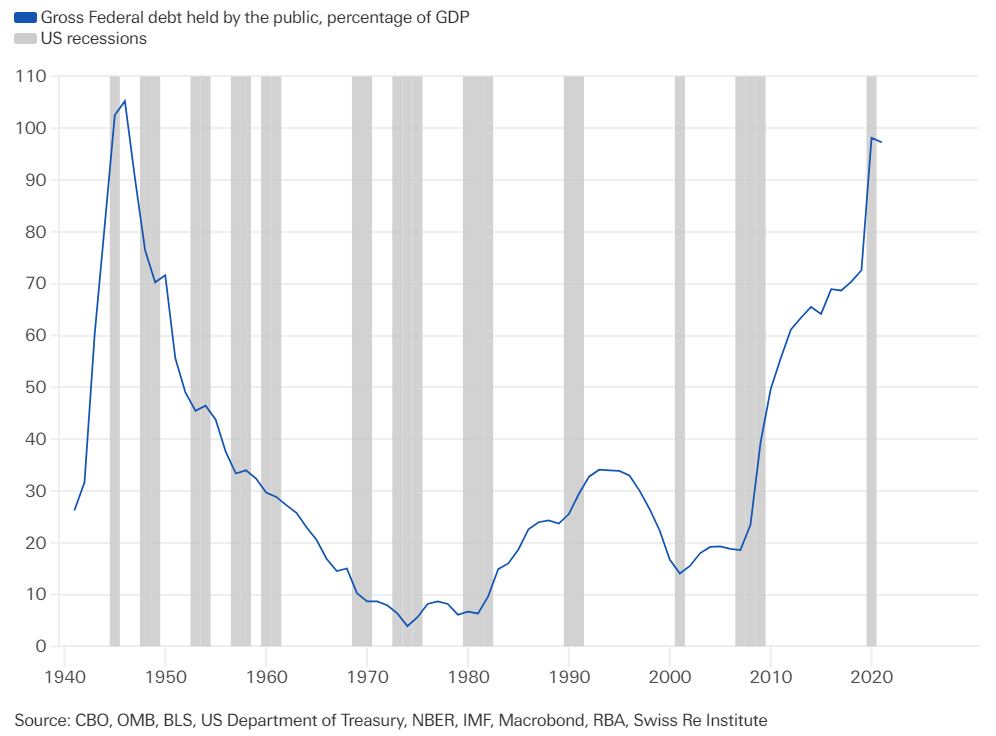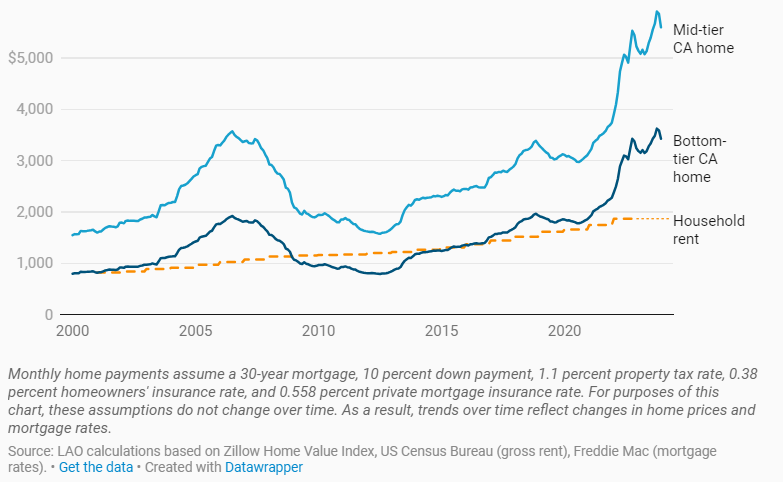Global stocks rally post pandemic was fueled by easy money (high liquidity and low interest rates), and that same thing is now going to kill this rally. In fact, long before the pandemic, most of the major countries had already been printing money at unprecedented rates since the 2008 global financial crisis. Excess money supply always leads to high inflation. So, at some point of time high inflation was inevitable. And that is what is happening now. Inflation started rising globally in 2021, which was temporarily controlled by raising rates by US and many other countries.
US inflation (CPI) had come down from over 8% to near 3% but has again started rising and is now 3.5%.
Figure 1 – US Inflation (CPI) and interest rates
Why US economy is relevant for all other countries
US is the world’s largest economy and its currency is the world’s reserve currency. Most global exports and imports take place in US dollars. If US enters a recession, most other countries will also be negatively affected, just like the 2000 and 2008 recessions. Even if the roots of problem lie in US, it will affect all other nations because world is interconnected by global trade. If global oil prices rise, it will rise in India also because India imports most of its oil. Inflation will be imported.
Why is this inflation a critical problem?
If we explore the real cause of this inflation, we will find that there are very high chances of this inflation making a catastrophic impact on global economy. Let us first look at the root cause of inflation which we have mentioned several times in past –
The key reason for expecting a global recession in near future is a continuing inflation. This inflation may rise for years like it did in 1970s. Its rise will be due to the unprecedented rise in money supply since the 2008 recession. Before the 1970s inflation, wars and other problems had forced U.S. government to increase money supply, which created inflation in 1970s. Now, just compare the two situations below –
- Since 1960 to 1970, money supply had increased at a CAGR of 3.94%, and inflation stayed above 5% for 10 years (1973 to 1982)
- Since 2008 to 2023, money supply increased at a CAGR of 25.2%, and inflation has just started rising!!
Compare 3.94% rise for 10 years with 25.2% for 15 years – it is devastating to think how long the inflation may last and how high it may go – it will be a complete destruction of global economy.
It is an unimaginable jump in money supply, never seen in the human history, it came in various forms – QE, QE1, QE2, QE3, ZIRP, bailouts, doles, backstops etc.
Links to previous related posts – Inflation Super Cycle, How long can inflation continue? Where to invest now?, Housing Bubble 2, The Biggest Recession is Coming (Part 1), Gold – Will its Price Rise Further?
US is between a rock and a hard place
If US raises interest rate –
- It will cause demand reduction leading to recession
- US will reach a dangerous level in debt cycle
If US lowers interest rates –
- It will certainly fire up inflation which can last for a very long time
- That inflation will lead to a severe recession
There is now way out.
Higher interest rates always lead to lower demand, which translates into recession.
If US raises interest rates or keeps at same level, government’s interest burden on its debt will become unmanageably high (see chart below) –
Figure 2 – Interest Burden
Just imagine your situation if your EMI burden doubles in just three years!
Figure 3 – US publicly held debt-to-GDP ratio
Pandemic forced US (and most other) government to raise debt to support economy, but it may become a vicious debt cycle.
US is now spending much more than what it earns (deficit). It borrows to fund that deficit, but with rising inflation, it may have to raise interest rates. That will increase its interest burden, that will further raise deficit. Then it will borrow even more!
The USD 1.7 trillion US deficit in the 2023 fiscal year cannot be reduced without drastic action such as major tax rises or spending cuts, either of which would likely trigger a recession. In the coming years, US debt is expected to rise dramatically to cover growing spending needs and higher interest expenses.
If you are a lender and believe that a borrower will be unable to repay your debt, you will either stop lending him or will charge very high interest rates to compensate for default risk. US is fast reaching that level where lenders will think twice before lending (also reflected in gold and bonds chart).
Fast rising deficits
Deficits need to be funded, when funded by printing money, it leads to inflation.
March 2024 US govt revenue –
- Total Revenue $332 billion
- Debt borrowing $236 billion
- Total Spending $569 billion.
Social Security, Medicare, Medicaid and interest on the debt exceeds all government revenue. Everything else in the budget has to be paid for with debt.
Figure 4 – US Deficit, March 2024
US budget is completely out of control and money printers are running non-stop. Winning the November election is the top driving factor for deficit. Biden has approved trillions in unnecessary spending, and his administration has taken actions such as college loan “forgiveness” to make deficits worse. Biden and his supporters in Congress constantly look for new ways to provide handouts to special interests. The American public pays the price. That country is doomed.
All these scenarios point towards a rise in inflation and a massive global disorder.
Indications that inflation is on rise
CPI has started rising (see figure 1 above)
Gold and silver are at record high prices, both are top indicators of inflation. Gold normally does not rise so fast, especially on no news. Western media is showing that it is a result of geo-political issues in middle east, but that is pure propaganda. Real reason is inflation expectation. All the helicopter money chickens are coming home to roost.
Most commodity prices are rising sharply and many are at record high levels. CRB index clearly shows this trend. It (Thomson Reuters/Core Commodity index) consists of 19 commodities: Aluminum, Cocoa, Coffee, Copper, Corn, Cotton, Crude Oil, Gold, Heating Oil, Lean Hogs, Live Cattle, Natural Gas, Nickel, Orange Juice, RBOB Gasoline, Silver, Soybeans, Sugar, and Wheat. The chart below shows CRB, gold, crude, all are now rising sharply –
Figure 5 – Rising commodity prices
Bond prices are falling, see comparison with gold below –
Figure 6 – Gold vs Bonds diversion
Largest 6 months divergence in history. While gold is up 26%, bonds are down 9%. Investors don’t want to buy US government bonds.
Monthly Payments for a Typical California Home have almost Doubled in just Last 4 years
Figure 7 – Monthly house loan payments
Monthly payments for a newly purchased mid-tier home—including mortgage, taxes, and homeowners’ insurance—have increased dramatically, almost doubled in last four years.
America’s biggest bank JP Morgan Chase has warned about tough times ahead. Jamie Dimon, the CEO of JP Morgan Chase, was very cautious in his annual shareholder letter. He mentions “yet another year of significant challenges” including the war in Ukraine, war in the Middle East, extreme tensions with China, higher food and energy prices, turmoil in the banking sector, outrageous government deficits, and even major risks with the Federal Reserve’s monetary policy. Dimon writes that “America’s global leadership role is being challenged outside by other nations and inside by our polarized electorate,” and that this is a “time of great crises”. Dimon writes how “ongoing fiscal [deficit] spending, remilitarization of the world, restructuring of global trade, capital needs of the new green economy, and possibly higher energy costs in the future” are all inflationary in the long run. And he is not alone, many experts have started sounding the alarm bells including Ray Dalio and Raghuram Rajan.
All these data indicate rising inflation.
Impact on stock market and bonds
Data is crystal clear; inflation is again on rise. If Fed maintains or raises interest rates, to control inflation, it will lead to demand destruction and recession and government will be closer to debt trap. If Fed reduces interest rates, it will lead to inflation and recession. Disaster is certain.
Both scenarios are unfavorable to stock markets and bonds.
Markets may realize it anytime – now to next year.
Economic conditions of most of the developed countries are much worse than what it was before the 2008 crisis. That crisis was managed by ultra-low interest rates and helicopter money. That easy money option is not available to governments anymore. In fact, they don’t have any option. The Great Depression had lasted ten years, this one may last even longer. It is difficult to estimate the impact of this risk, but suffice to say that it can be a bigger economic crisis than what mankind has ever seen.
What are the best ways to invest if stocks rally is going to end
Gold will perform better but finding the right entry time is crucial as at such record high levels, there may be wild swings in its price.
A market neutral hedge strategy may work well.
Certain global ETFs (US listed) can do well in inflationary scenario. Indians can invest up to $250000 (around Rs 2 cr) in US stocks and ETFs.
You should check our affordable offerings – Hedged Plan and Adaptive Plan, both designed to handle investments during tough times.






